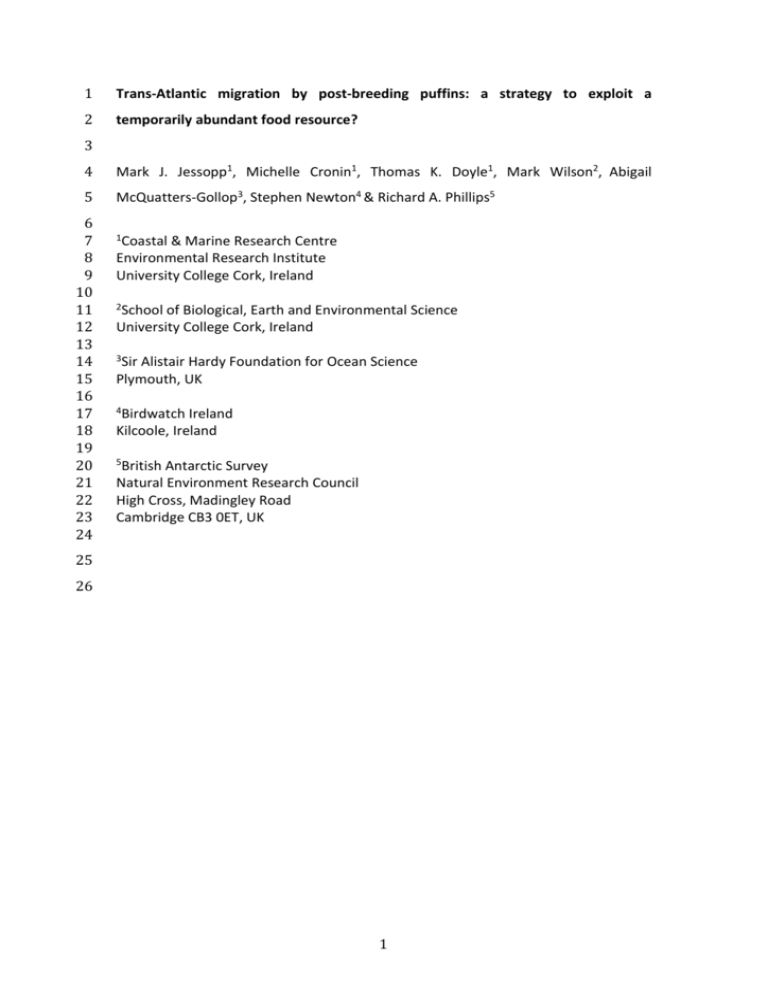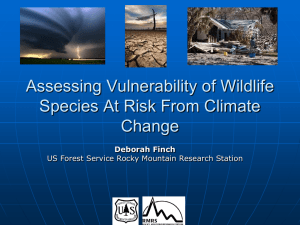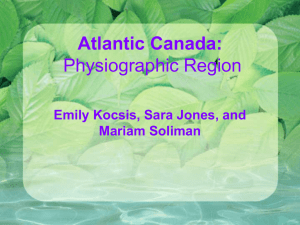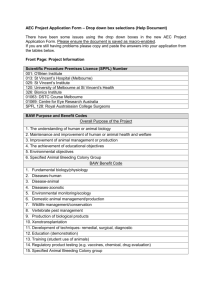coast abundance
advertisement

1 Trans-Atlantic migration by post-breeding puffins: a strategy to exploit a 2 temporarily abundant food resource? 3 4 Mark J. Jessopp1, Michelle Cronin1, Thomas K. Doyle1, Mark Wilson2, Abigail 5 McQuatters-Gollop3, Stephen Newton4 & Richard A. Phillips5 6 7 8 9 10 11 12 13 14 15 16 17 18 19 20 21 22 23 24 1Coastal & Marine Research Centre Environmental Research Institute University College Cork, Ireland 2School of Biological, Earth and Environmental Science University College Cork, Ireland 3Sir Alistair Hardy Foundation for Ocean Science Plymouth, UK 4Birdwatch Ireland Kilcoole, Ireland 5British Antarctic Survey Natural Environment Research Council High Cross, Madingley Road Cambridge CB3 0ET, UK 25 26 1 27 Abstract 28 29 The distribution of Atlantic puffins (Fratercula arctica) from southwest Ireland was 30 investigated using geolocation loggers between the 2010 and 2011 breeding seasons. 31 All tracked birds travelled rapidly west into the north Atlantic at the end of the 32 breeding season in August, with the majority undertaking trans-Atlantic trips from 33 Ireland to Newfoundland. The furthest distance from the colony reached by each 34 bird was not influenced by body mass or sex, and was achieved in approximately 20 35 days. By October, all birds had moved back to the mid Atlantic where they remained 36 resident until returning to the breeding colony. The most parsimonious explanation 37 for the rapid, directed long-distance migration is that birds exploit the seasonally 38 high abundance of spawning capelin Mallotus villosus off the Canadian coast, which 39 is also utilised by large populations of North American seabirds at this time. Once 40 this short-term prey resource has diminished, the tracked puffins moved back 41 towards the northeast Atlantic. A relationship between relative abundance of puffins 42 and zooplankton was found in all winter months, but after correcting for spatial 43 autocorrelation, was only significant in November and January. Nevertheless, these 44 results suggest a potential switch in diet from mainly fish in the early winter, to 45 zooplankton. This study suggests that puffins from southwest Ireland have a long- 46 distance migration strategy that is rare in breeding birds from the UK, and identifies 47 a key non-breeding destination for puffins from Ireland. This has implications for the 48 susceptibility of different breeding populations to the effects of possible climatic or 49 oceanographic change. 50 51 52 53 Keywords: Atlantic puffin; Fratercula arctica; geolocation; migration; plankton density 2 54 Introduction 55 56 Most seabirds undertake long migrations following the breeding season. This 57 behaviour is thought to be an adaptive strategy to avoid seasonal deterioration in 58 climate or increasing scarcity of resources around colonies at the end of the 59 breeding season (Newton 2010). However, considerable energy is required to travel 60 large distances, and migrating birds often need to transit through unproductive 61 areas to reach their main nonbreeding grounds (Mackley et al. 2010; Landers et al. 62 2011). 63 64 The Atlantic puffin Fratercula arctica is a common, pursuit-diving seabird which 65 breeds on coastal cliffs and islands in the North Atlantic, but is entirely pelagic during 66 the nonbreeding period. Puffins have a small wing area relative to body weight that 67 has been suggested to be a compromise between aerial flight and underwater 68 maneuverability (Wilson et al. 1992), although Storer (Storer 1960) suggests that 69 small wings evolved to be efficient for high speed, long distance flight rather than for 70 use underwater. As a result, puffins have one of the highest energetic costs of flight 71 across a range of bird groups (Vandenabeele et al. 2012), with an estimated flap-rate 72 of 300-400 beats per minute (Meinertzhagen 1955). Despite this, young birds from 73 British and Irish colonies may travel extensively throughout the north Atlantic as 74 evidenced by ring recoveries off Newfoundland (Lyngs 2003). Furthermore, the 75 results of two recent studies using geolocation technology show that adult Atlantic 76 puffins disperse widely during the non-breeding period (Harris et al. 2010; Guilford 77 et al. 2011). Many birds in these two studies dispersed into the Atlantic after the 78 breeding season, with little evidence that they were targeting particular areas. An 79 “exploration-refinement” hypothesis for puffin migration has been suggested 80 (Guilford et al. 2011), describing a reliance by pre-breeding puffins on large-scale 81 exploratory movements, which become refined into an individual migratory route 82 and set of destinations through learning. This was considered to be the most likely 83 explanation for the high consistency among years in the migratory route and 84 destination of individual puffins (Guilford et al. 2011), as recorded in other marine 85 migrants (Broderick et al. 2007; Jorgensen et al. 2010). The degree of plasticity in 3 86 migratory behavior affects the ability to adapt to environmental change (Dias et al. 87 2011). Despite the limited annual variation in the migratory routes of individual 88 puffins, and the fact that detailed data on individual puffin migrations has only 89 recently become available, a recent change in the distribution of adult puffins 90 outside the breeding season from a major North Sea colony has already been 91 documented (Harris et al. 2010). 92 93 In Ireland, breeding puffins are concentrated on the west and southwest coasts 94 (Mitchell et al. 2004). Little is known about the non-breeding distribution of most 95 seabirds from Ireland, which are at the westerly extremes of the European breeding 96 ranges. Without this information, it is impossible to predict the impacts of 97 fluctuations in resource availability resulting from environmental change or over- 98 fishing. The objectives of this study were to determine the winter distribution and 99 possible environmental drivers of the seasonal shift in distribution of puffins 100 breeding in southwest Ireland. 101 102 103 Methods 104 105 Twenty-four adult birds were captured and tagged towards the end of the breeding 106 season (24-26th July) in 2010 on Skellig Michael, Co. Kerry, Ireland (51.77°N, 10.54°W, 107 Fig. 1). Birds were captured during late chick-rearing using purse nets at burrow 108 entrances on return to the colony. Birds were weighed and fitted with a British 109 Antarctic Survey Mk18 geolocator device attached to a coloured Darvic ring fitted to 110 the tarsus. Each device measured approximately 15x10x6mm and weighed 1.5g. 111 Total deployment weight (device plus leg ring and cable tie attachment) was 2.8g, 112 representing approximately 0.7% of average body mass. Breast feathers were 113 sampled for genetic identification of sex before the birds were returned to their 114 burrows. Logistical constraints limited access to the island for tag recovery to two 115 weekends in early and late July 2011 to recover instrumented birds. 116 4 117 Data were downloaded from retrieved loggers, decompressed and processed using 118 TransEdit and Locator in the BASTrak software suite (British Antarctic Survey, 119 Cambridge). Light level data were processed using a sun elevation angle of -4.5, 120 based on calibration data from loggers at a fixed location. During processing, dawn 121 and dusk transitions were filtered according to a minimum dark period of 4 hours. 122 Any transitions with obvious interruptions to light curves were noted, and the 123 resulting locations checked visually and excluded from analyses as appropriate. 124 Location estimates occurring within 2-3 weeks either side of the vernal equinox that 125 were clearly affected by inaccuracy of latitude estimation were removed from the 126 analysis (although longitude information was retained), as were locations 127 representing movements of more than 500km day-1. Accuracy of validated locations 128 is in the region of ±200km (Phillips et al. 2004). Date of departure from the colony 129 and onset of migration was considered to be the date that birds were last recorded 130 within 500km of the colony given the accuracy of geolocation estimates and since it 131 was apparent from the data that some birds spent a period of days at sea before 132 returning briefly to the colony before migration. The terminus of directed westerly 133 migration was identified by visual inspection. The distance travelled west on the 134 outward (postbreeding) migration was the great-circle distance between the 135 breeding colony and the mean latitude and longitude of the eight most westerly, 136 validated locations (to account for variability in position error). The relationship 137 between distance travelled west and body mass was examined using linear 138 regression, while the relationship between distance travelled and gender was 139 examined using a Mann-Whitney U test. 140 141 Non-breeding distributions of the tracked birds were examined in relation to 142 potential prey availability. Data on zooplankton abundance were from the 143 Continuous Plankton Recorder (CPR) survey for 1985-2010, and obtained from the 144 Sir Alistair Hardy Foundation for Ocean Science (SAHFOS). The CPR is an upper layer 145 plankton sampler towed behind vessels of opportunity along regular shipping routes. 146 The device filters seawater at a depth of 7–9m on a moving band of silk. The silk is 147 divided into samples, with each sample representing approximately 10 nautical miles 148 of towing and 3m3 of filtered seawater, and effectively captures relative abundance 5 149 of zooplankton (Richardson et al. 2006). Copepod abundance in many parts of the 150 North Atlantic has declined over the past 40 years, indicating geographical shifts in 151 plankton communities (Pitois and Fox 2006). Given these changes and the high 152 spatial and temporal variability in sampling effort, only records from 1990 to 2010 153 (the most recent available data) were used to identify areas of persistently high 154 zooplankton abundance. 155 156 Dietary information from puffins suggests consumption of large zooplankton species, 157 including euphausiids and amphipods over 12mm in size (Falk et al. 1992; Hedd et al. 158 2010). Data on large zooplankton (euphausiids, gammarids, hyperiids, decapod 159 larvae, siphonophores, chaetognaths, salps, mysids, cephalopod larvae, and fish 160 larvae) were therefore selected from the CPR data for analysis. Abundance 161 (individuals per m3) of all large zooplankton species combined, as well as separately 162 for euphausiids given their prevalence in CPR data, was mapped using Inverse 163 Distance Weighted (IDW) interpolation on a 1° grid which is roughly comparable to 164 the accuracy of the GLS positions (Phillips et al. 2004), using a node search radius of 165 3°. Puffin densities in each cell within a 1°x1° grid across the North Atlantic were 166 estimated for each month from August to February as the number of individual 167 positions recorded in that cell. In each month, the relationship between relative bird 168 density and zooplankton abundance was investigated using Dutilleul’s modified T- 169 test (Dutilleul 1993) to account for spatial autocorrelation using the freely available 170 PASSaGE 2.0 software (Rosenberg and Anderson 2011). This method reduces the 171 degrees of freedom in proportion to the degree of spatial autocorrelation in the data 172 (Haining 1991). 173 174 Monthly average and long-term (1981-2010) monthly average zonal (east-west 175 direction) wind velocity at a 2.5° resolution data were obtained from the National 176 Oceanic & Atmospheric Administration (NOAA) Physical Sciences Division 177 (http://www.esrl.noaa.gov/psd/data/gridded/data.ncep.reanalysis.derived.surface.h 178 tml) to determine whether there was a relationship with wind speed and direction 179 and the timing and bearing of outward migration routes taken by tracked birds. 180 6 181 Results 182 183 Ten birds were successfully recaptured at the colony one year after deployment. A 184 further five individuals were observed at the colony that evaded recapture. The 185 colony is located on a UNESCO world heritage site, and restoration works on a 186 monastic wall resulted in the burrows of four tagged birds being built over between 187 deployment and recovery of the devices. These birds were not resighted in the 188 colony the following year. This and the limited time available in the colony for 189 recapture (2 weekends in early and late July 2011) resulted in an overall resighting 190 rate of only 62.5%. A summary of bird metrics and details of migration is given in 191 Table I. Data were available for 4 females, 5 males, and 1 bird of unknown sex (the 192 feather sample did not yield enough genetic material for reliable sexing). 193 194 All tagged birds commenced a directed westerly migration at the end of the 195 breeding season. Six birds (3 males, 3 females) travelled from southwest Ireland 196 across the North Atlantic to the coast of Canada, typically taking approximately 20 197 days to make the journey and spending 15-42 days in waters off Newfoundland or 198 the Labrador shelf. The remaining four birds migrated as far as waters off southern 199 Greenland. Although there was considerable variation among birds in the extent of 200 the initial outward migration and subsequent movement patterns, all spent the 201 majority of the winter months in the central Atlantic Ocean southeast of Greenland, 202 moving closer to Ireland in spring months. This is consistent with the timing of 203 breeding birds returning to the colony to excavate burrows and (re)establish pair 204 bonds. One bird (17817) spent 1-2 months in the Mediterranean Sea in 205 January/February before returning to the colony (Fig 2). 206 207 The prevailing winds during the month of August 2010, when puffins departed the 208 colony, were westerlies, indicating that the tracked puffins were largely travelling 209 into headwinds. This was consistent wit the long-term (1981-2010) monthly average 210 winds for August (Figs 3 a,b). The distance migrated west from the colony (to the 211 average of the 8 most westerly, reliable fixes), ranged from 1722-3165km (mean 212 2537 ± 506km). There was no significant effect of bird mass (F1,9 = 0.68, P= 0.435) or 7 213 sex (W=24, P=0.391) on the distance travelled west during the initial outward 214 journey from the breeding colony. 215 216 Despite interpolating the zooplankton densities using a 3-degree search radius, some 217 areas of the North Atlantic were un-sampled or poorly represented as CPR sampling 218 effort is largely opportunistic. There was significant spatial autocorrelation in the 219 data on puffin relative abundance in all months (Morans I statistic, P<0.01 in all 220 months), violating the assumption of independence of residuals and leading to 221 increased chance of Type I error. We therefore used Dutilleul’s modified T-test, 222 which takes into account spatial autocorrelation, to test for significance of the 223 correlation using 5 equidistant classes. After accounting for spatial autocorrelation, 224 the correlations that remained significant were those between abundance of puffins 225 and that of large zooplankton and euphausiids in November, and of euphausiids only 226 in January (Table II). 227 228 Discussion 229 230 All tracked Atlantic puffins undertook rapid, directed westerly migration into the 231 Atlantic Ocean at the beginning of the non-breeding period, departing the colony 232 between the 29th July and 14th August. Most puffins have left British colonies by the 233 middle of August, with the main exodus from the intensively monitored colony on 234 the Isle of May typically occurring within the first week of August (Harris and 235 Wanless 2011). Six of the 10 birds travelled to the east Canadian coast where they 236 remained throughout August and September, while the remaining four birds 237 travelled as far west as the southern tip of Greenland. 238 239 Those puffins from Ireland that have travelled as far as the Newfoundland/Labrador 240 area were therefore feeding in the same area (and presumably on the same food) as 241 North American puffins, of which there are an estimated 350,000-400,000 breeding 242 pairs (Lowther et al. 2002). Baillie & Jones (2004) report median fledging dates for 243 puffins on the Gannet Islands, Labrador, between 1981 and 1998 as 9-21 September, 244 while Lowther et al. (2002) report fledging from mid-August to early September, 8 245 indicating that North American puffins are still provisioning chicks until this time. 246 Despite having undertaken such a long journey, the puffins tracked in this study did 247 not spend long periods off the east coast of Canada, remaining there for 15-42 days 248 before returning eastwards. The reason why residency times off Canada were so 249 short is unclear, although it is likely to be related to availability of prey resources. 250 Optimal foraging theory suggests that some individuals may exploit new areas or 251 prey that are further afield, when doing so outweighs the energetic costs of 252 movement (Pyke 1978). During the early post-breeding period zooplankton 253 abundance was generally patchy, and large zooplankton were uncommon off 254 Newfoundland (unpublished data). 255 256 However, a seasonally abundant prey species off the Canadian coast is capelin, a 257 small, pelagic schooling fish. Adult fish range in size from 12-23cm, and at maturity, 258 schools of adults migrate to spawn on Newfoundland beaches and demersal sites 259 (Davoren et al. 2006). Recent studies in the northwest Atlantic show that spawning 260 of capelin is now c. 4 weeks later than in the 1980s, with arrival ranging from 12 June 261 to 23 August (Regular et al. 2009), and an increased tendency towards demersal 262 spawning (Davoren et al. 2008). Eggs deposited on shallow beach sediment typically 263 emerge 10-12 days later (Nakashima and Wheeler 2002), while colder temperatures 264 at depths associated with demersal spawning prolong larval development and result 265 in later emergence (DFO 2011). Larvae exit the sediment and are carried out of bays 266 in large numbers by surface currents. Therefore, the period throughout August- 267 September coincides with high local abundances of both spawning capelin and 268 emerging larvae. Capelin features heavily in the diet of Atlantic puffins rearing chicks 269 in Newfoundland during August and early September (Lowther et al. 2002), and 270 there is a strong correlation between the abundance of puffins and capelin in 271 inshore waters at this time of year (Piatt 1990). Large numbers of other capelin 272 predators, including common Uria aalge and Brunnich’s guillemots U. lomvia (both 273 local birds and migrants from further north) also use the waters off Labrador and the 274 Grand Banks, as do nonbreeding kittiwakes Rissa tridactyla (González-Solís et al. 275 2011) and great skuas Stercorarius skua from the east Atlantic (Magnusdottir et al. 9 276 2012). 277 278 The mean calorific density of adult capelin in August-October varies from 5.3 – 8.3 279 kJ/g wet mass (Barrett et al. 1987; Øyan and Anker-Nilssen 1996). By comparison, 280 most zooplankton species, which dominate puffin diet elsewhere during the winter 281 months (Falk et al. 1992; Hedd et al. 2010) are much smaller and less energy-rich. 282 Mean energy densities of amphipods, euphausiids, cnidarians, and cephalopods 283 from the north Atlantic are 5.44, 3.4, 0.7, and 4.4kJ/g wet mass respectively, and the 284 overall mean for crustacean zooplankton is c. 1.6kJ/g wet mass (Steimle and 285 Terranova 1985; Spitz et al. 2010). Atlantic puffins have a reported daily requirement 286 of 1065kJ/day (Lilliendahl and Solmundsson 1997). Presumably, meeting this 287 requirement through consumption of capelin, which are comparatively large 288 (spawning males average 183mm, 42.1g; spawning females 158mm, 20-29g) and 289 energy-rich (Montevecchi and Piatt 1984), would result in a higher rate of energy 290 intake than foraging on even high calorific content zooplankton prey such as 291 copepods, euphausiids, mysids and chaetognaths (Davis 1993), which are 292 comparatively small, and would require additional foraging effort even if highly 293 aggregated. 294 295 Considerable time from October onwards, presumably after the abundance of 296 capelin off Newfoundland had declined, was spent in a broad area to the southeast 297 of Greenland that has recently been recognized as a pelagic seabird biodiversity 298 hotspot (Boertmann 2011; Wakefield et al. 2011; Montevecchi et al. 2012). Hedd et 299 al. (2010) showed that the winter diet of Atlantic puffins was dominated by 300 zooplankton, and despite there being relatively few areas of high zooplankton 301 abundance (unpublished data) in the area, a significant correlation was found 302 between relative puffin density and zooplankton abundance in November and 303 January. Puffin distribution correlated best with that of a single prey group, 304 euphausiids, which is also consistent with other studies linking seabird distribution 305 to zooplankton prey. A positive correlation between little auks (Alle alle) and large 10 306 copepod Calanus finmarchicus densities was found in the North Atlantic (2012), and 307 it has been suggested that seabird distributions are more likely to reflect those of 308 one or more key taxa rather than all types of zooplankton (Sydeman et al. 2010). The 309 lack of a strong correlation between puffin and zooplankton abundance in other 310 months may be due to annual or seasonal changes in distribution of puffins or 311 plankton. Plankton data were averaged over 20 years, whereas the puffin tracking 312 data were from just one year, and both distributions will to some degree vary as a 313 consequence of climatic or oceanographic changes (Pitois and Fox 2006). 314 Alternatively, the synchronous moult of their primary feathers during the winter 315 renders puffins flightless for a period of weeks (Harris and Wanless 2011), and may 316 reduce their ability to track prey patches, or they may actively avoid areas with high 317 plankton densities during this time if these attract generalist predators such as great 318 skuas and sharks. 319 320 While strong winds have been known to divert migrating birds off-course, and 321 wrecks of larger alcids have been recorded (Underwood and Stowe 1984; McFarlane 322 Tranquilla et al. 2010), the puffins tracked in this study were clearly not blown from 323 Ireland to Newfoundland. The observed westerly migration was against prevailing 324 winds, so presumably, high abundances of capelin provide a rich source of energy 325 that outweighs the energetic cost of such a long migration. Long-distance migrations 326 by birds taking advantage of highly seasonal food availability have also been 327 observed in shearwaters (Shaffer et al. 2006; Guilford et al. 2009). While multi-year 328 data are not currently available for Irish populations, a remarkable degree of 329 repeatability in the direction and extent of migration in puffins tagged on Skomer 330 has been reported (2011). Puffins from Ireland that visited the eastern Canadian 331 coast as pre-breeders (ring recoveries of young birds from British colonies off 332 Newfoundland have been noted, Lyngs 2003), would presumably have experienced 333 high foraging success on capelin, and be likely to return there as adults. The rapid 334 and directed movement of puffins tracked from southwest Ireland is consistent with 335 the “exploration-refinement” hypothesis for migration, where puffins rely on a 336 system of large-scale exploratory movements during the prebreeding years, which 337 become refined into an individual migratory route and set of destinations (Guilford 11 338 et al. 2011). 339 Delays in the timing of arrival of capelin in inshore waters has led to delayed 340 breeding chronology in common guillemots (Davoren and Montevecchi 2003; 341 Regular et al. 2009). The median lay date of Atlantic puffins in a Maine study 342 population was 15th - 21st June in 1985 (Kress and Nettleship 1988), so the majority 343 of broods would therefore be expected to fledge by mid-August. It seems that there 344 has also been a shift in breeding chronology of puffins in the west Atlantic over the 345 past 2 decades, with puffins now rearing chicks into early September (Lowther et al. 346 2002), mirroring the later spawning of capelin. Long time-series of breeding data 347 from the 1980s and 1990s from St Kilda (Harris et al. 1998) and Norway (Durant et al. 348 2004) suggest that in the east Atlantic there has not been any systematic shift in 349 timing of breeding; hence, if post-breeding migration of Irish puffins is motivated by 350 capelin, it seems likely that it is a recent phenomenon. 351 352 A long-distance migration to avail of abundant capelin may put post-breeding puffins 353 from Ireland at risk, as fidelity to non-breeding destinations in seabirds is usually 354 high (but see Dias et al. 2011). Large declines in capelin abundance off Labrador and 355 Newfoundland have been noted, with the 2010 estimate of abundance from spring 356 acoustic surveys being about 10% of 2007-2009 values and 1% of historical levels 357 (DFO 2011). Our results have identified a key non-breeding destination for migrating 358 puffins, and suggest that reliable prey aggregations are important. However, this 359 study also highlights the need for multi-year data to determine if puffins breeding at 360 the western edge of the European range exhibit sufficient plasticity in migration 361 strategies to adequately respond to environmental change. 362 363 364 Acknowledgements 365 We wish to thank Grellan Rourke from the Office of Public Works for facilitating 366 access to accommodation on Skellig Michael, and Clare Heardman (NPWS) and Dave 367 Thompson (National Trust) for assistance in the field. All puffin capture, handling and 368 tagging procedures were reviewed and approved by the National Parks and Wildlife 12 369 Service, and carried out under licence Numbers 26/2010 and C051/2011 issued by 370 National Parks and Wildlife Service, Department of Environment, Heritage and Local 371 Government. The study was funded by a Beaufort Marine Research Award provided 372 under the Sea Change Strategy and the Strategy for Science Technology and 373 Innovation (2006-2013), with the support of the Marine Institute, funded under the 374 Marine Research Sub-Programme of the National Development Plan 2007–2013. 375 Two authors also received funding from the European Community's Seventh 376 Framework 377 Management for Europe's Seas (KnowSeas-, grant agreement N° 226675). Programme (FP7/2007-2013) Knowledge-based Sustainable 378 379 References 380 381 382 383 384 385 386 387 388 389 390 391 392 393 394 395 396 397 398 399 400 401 402 403 404 405 406 407 408 409 Baillie SM, Jones IL (2004) Response of Atlantic Puffins to a decline in capelin abundance at the Gannet Islands, Labrador. Waterbirds 27: 102-111 Barrett RT, Anker-Nilssen T, Rikardsen F, Valde K, Røv N, Vader W (1987) The Food, Growth and Fledging Success of Norwegian Puffin Chicks Fratercula arctica in 1980-1983. Ornis Scandinavica 18: 73-83 Boertmann D (2011) Seabirds in the central North Atlantic, September 2006: further evidence for an oceanic seabird aggregation area. Marine Ornithology 39: 183-188 Broderick AC, Coyne MS, Fuller WJ, Glen F, Godley BJ (2007) Fidelity and overwintering of sea turtles. Proceedings of the Royal Society B: Biological Sciences 274: 1533-1539 Davis ND (1993) Caloric content of oceanic zooplankton and fishes for studies of salmonid food habits and their ecologically related species. (NPAFC Doc.) FRIUW-9312. Fisheries Research Institute, University of Washington, Seattle Davoren G, May C, Penton P, Reinfort B, Buren A, Burke C, Andrews D, Montevecchi W, Rose-Taylor C, Bell T (2008) An Ecosystem-Based Research Program for Capelin (Mallotus villosus) in the Northwest Atlantic: Overview and Results. J Northw Atl Fish Sci 39: 35-48 Davoren GK, Anderson JT, Montevecchi WA (2006) Shoal behaviour and maturity relations of spawning capelin (Mallotus villosus) off Newfoundland: demersal spawning and diel vertical movement patterns. . Canadian Journal of Fisheries and Aquatic Sciences 63: 268-284 Davoren GK, Montevecchi WA (2003) Signals from seabirds indicate changing biology of capelin stocks. Marine Ecology Progress Series 258: 253-261 doi 10.3354/meps258253 DFO (2011) Assessment of capelin in SA 2 + Div. 3KL in 2010. DFO Canadian Science Advisory Secretariat Science Advisory Report 2010/090 Dias MP, Granadeiro JP, Phillips RA, Alonso H, Catry P (2011) Breaking the routine: individual Cory's shearwaters shift winter destinations between hemispheres 13 410 411 412 413 414 415 416 417 418 419 420 421 422 423 424 425 426 427 428 429 430 431 432 433 434 435 436 437 438 439 440 441 442 443 444 445 446 447 448 449 450 451 452 453 454 and across ocean basins. Proceedings of the Royal Society B: Biological Sciences 278: 1786-1793 Durant JM, Anker-Nilssen T, Hjermann DØ, Stenseth NC (2004) Regime shifts in the breeding of an Atlantic puffin population. Ecology Letters 7: 388-394 doi 10.1111/j.1461-0248.2004.00588.x Dutilleul P (1993) Modifying the t test for assessing the correlation between two spatial processes. Biometrics 49: 305-314 Falk K, Jensen JK, Kampp K (1992) Winter diet of Atlantic puffins (Fratercula arctica) in the northeast Atlantic. Colonial Waterbirds: 230-235 Fort J, Beaugrand G, Grémillet D, Phillips RA (2012) Biologging, Remotely-Sensed Oceanography and the Continuous Plankton Recorder Reveal the Environmental Determinants of a Seabird Wintering Hotspot. PloS one 7: e41194 González-Solís J, Smyrli M, Militão T, Gremillet D, Tveraa T, Phillips RA, Boulinier T (2011) Combining stable isotope analyses and geolocation to reveal kittiwake migration. Marine Ecology Progress Series 435: 251-261 Guilford T, Freeman R, Boyle D, Dean B, Kirk H, Phillips R, Perrins C (2011) A Dispersive Migration in the Atlantic Puffin and Its Implications for Migratory Navigation. PloS one 6: e21336 Guilford T, Meade J, Willis J, Phillips RA, Boyle D, Roberts S, Collett M, Freeman R, Perrins CM (2009) Migration and stopover in a small pelagic seabird, the Manx shearwater Puffinus puffinus: insights from machine learning. Proceedings of the Royal Society B: Biological Sciences 276: 1215-1223 doi 10.1098/rspb.2008.1577 Haining R (1991) Bivariate correlation with spatial data. Geographical Analysis 23: 210-227 Harris M, Daunt F, Newell M, Phillips R, Wanless S (2010) Wintering areas of adult Atlantic puffins Fratercula arctica from a North Sea colony as revealed by geolocation technology. Marine Biology 157: 827-836 Harris MP, Murray S, Wanless S (1998) Long-term changes in breeding performance of Puffins Fratercula arctica on St Kilda. Bird Study 45: 371-374 doi 10.1080/00063659809461109 Harris MP, Wanless S (2011) The puffin. Poyser, London Hedd A, Fifield DA, Burke CM, Montevecchi WA, Tranquilla LMF, Regular PM, Buren AD, Robertson GJ (2010) Seasonal shift in the foraging niche of Atlantic puffins Fratercula arctica revealed by stable isotope (δ 15 N and δ 13 C) analyses. Aquatic Biology 9: 13-22 Jorgensen SJ, Reeb CA, Chapple TK, Anderson S, Perle C, Van Sommeran SR, FritzCope C, Brown AC, Klimley AP, Block BA (2010) Philopatry and migration of Pacific white sharks. Proceedings of the Royal Society B: Biological Sciences 277: 679-688 Kress SW, Nettleship DN (1988) Re-Establishment of Atlantic Puffins (Fratercula arctica) at a Former Breeding Site in the Gulf of Maine (Re-Establecimiento del Frailecillo del Atlantico (Fratercula arctica) en el Golfo de Maine). Journal of Field Ornithology: 161-170 14 455 456 457 458 459 460 461 462 463 464 465 466 467 468 469 470 471 472 473 474 475 476 477 478 479 480 481 482 483 484 485 486 487 488 489 490 491 492 493 494 495 496 497 498 499 500 Landers TJ, Rayner MJ, Phillips RA, Hauber ME (2011) Dynamics of seasonal movements by a trans-Pacific migrant, the Westland petrel Procellaria westlandica. Condor 113: 71-79 Lilliendahl K, Solmundsson J (1997) An estimate of summer food consumption of six seabird species in Iceland. ICES Journal of Marine Science 54: 624 Lowther PE, Diamond AW, Kress SW, Robertson GJ, Russell K (2002) Atlantic Puffin (Fratercula arctica). In: Poole A, Gill F (eds) Birds of North America, Philadelphia Lyngs P (2003) Migration and winter ranges of birds in Greenland. Danish Ornithological Society Mackley EK, Phillips RA, Silk JRD, Wakefield ED, Afanasyev V, Fox JW, Furness RW (2010) Free as a bird? Activity patterns of albatrosses during the nonbreeding period. Marine Ecology Progress Series 406: 291-303 Magnusdottir E, Leat EHK, Bourgeon S, Strøm H, Petersen A, Phillips RA, Hanssen SA, Bustnes JO, Hersteinsson P, Furness RW (2012) Wintering areas of great skuas Stercorarius skua breeding in Scotland, Iceland and Norway. Bird Study 59: 1-9 McFarlane Tranquilla L, Hedd A, Burke C, Montevecchi WA, Regular PM, Robertson GJ, Stapleton LA, Wilhelm SI, Fifield DA, Buren AD (2010) High Arctic sea ice conditions influence marine birds wintering in Low Arctic regions. Estuarine, Coastal and Shelf Science 89: 97-106 doi http://dx.doi.org/10.1016/j.ecss.2010.06.003 Meinertzhagen R (1955) The speed and altitude of bird flight. Ibis 78: 81-117 Mitchell PE, Newton SF, Ratcliffe N, Dun TE (2004) Seabird populations of Britain and Ireland. Results of the Seabird 2000 census (1998-2002). A&C Black publishers Ltd, London Montevecchi W, Hedd A, McFarlane Tranquilla L, Fifield D, Burke C, Regular P, Davoren G, Garthe S, Robertson G, Phillips R (2012) Tracking seabirds to identify ecologically important and high risk marine areas in the western North Atlantic. Biological Conservation 156: 62-71 Montevecchi WA, Piatt J (1984) Composition and energy contents of mature inshore spawning capelin (mallotus villosus): Implications for seabird predators. Comparative Biochemistry and Physiology Part A: Physiology 78: 15-20 doi 10.1016/0300-9629(84)90084-7 Nakashima BS, Wheeler JP (2002) Capelin (Mallotus villosus) spawning behaviour in Newfoundland waters–the interaction between beach and demersal spawning. ICES Journal of Marine Science: Journal du Conseil 59: 909-916 Newton I (2010) Bird migration. HarperCollins UK Øyan HS, Anker-Nilssen T (1996) Allocation of growth in food-stressed Atlantic Puffin chicks. The Auk: 830-841 Phillips R, Silk J, Croxall J, Afanasyev V, Briggs D (2004) Accuracy of geolocation estimates for flying seabirds. Marine Ecology Progress Series 266: 265-272 Piatt JF (1990) The aggregative response of common murres and Atlantic puffins to schools of capelin. Studies in Avian Biology 14: 36-51 Pitois SG, Fox CJ (2006) Long-term changes in zooplankton biomass concentration and mean size over the Northwest European shelf inferred from Continuous 15 501 502 503 504 505 506 507 508 509 510 511 512 513 514 515 516 517 518 519 520 521 522 523 524 525 526 527 528 529 530 531 532 533 534 535 536 537 538 539 540 541 542 543 544 545 546 547 Plankton Recorder data. ICES Journal of Marine Science: Journal du Conseil 63: 785-798 doi 10.1016/j.icesjms.2006.03.009 Pyke GH (1978) Optimal foraging: movement patterns of bumblebees between inflorescences. Theoretical Population Biology 13: 72-98 Regular PM, Shuhood F, Power T, Montevecchi WA, Robertson GJ, Ballam D, Piatt JF, Nakashima B (2009) Murres, capelin and ocean climate: inter-annual associations across a decadal shift. Environ Monit Assess 156: 293-302 doi 10.1007/s10661-008-0484-2 Richardson A, Walne A, John A, Jonas T, Lindley J, Sims D, Stevens D, Witt M (2006) Using continuous plankton recorder data. Progress In Oceanography 68: 2774 Rosenberg MS, Anderson CD (2011) PASSaGE: Pattern Analysis, Spatial Statistics and Geographic Exegesis. Version 2. . Methods in Ecology and Evolution 2: 229232 Shaffer SA, Tremblay Y, Weimerskirch H, Scott D, Thompson DR, Sagar PM, Moller H, Taylor GA, Foley DG, Block BA (2006) Migratory shearwaters integrate oceanic resources across the Pacific Ocean in an endless summer. Proceedings of the National Academy of Sciences 103: 12799 Spitz J, Mourocq E, Schoen V, Ridoux V (2010) Proximate composition and energy content of forage species from the Bay of Biscay: high-or low-quality food? ICES Journal of Marine Science: Journal du Conseil 67: 909-915 Steimle F, Terranova RJ (1985) Energy equivalents of marine organisms from the continental shelf of the temperate northwest Atlantic. J Northw Atl Fish Sci 6: 117-124 Storer RW (1960) Evolution of the diving birds. Proceedings 12th International Ornithological Congress: 55-70 Sydeman WJ, Thompson SA, Santora JA, Henry MF, Morgan KH, Batten SD (2010) Macro-ecology of plankton–seabird associations in the North Pacific Ocean. Journal of Plankton Research 32: 1697-1713 doi 10.1093/plankt/fbq119 Underwood L, Stowe T (1984) Massive wreck of seabirds in eastern Britain, 1983. Bird Study 31: 79-88 Vandenabeele S, Shepard E, Grogan A, Wilson R (2012) When three per cent may not be three per cent; device-equipped seabirds experience variable flight constraints. Marine Biology 159: 1-14 doi 10.1007/s00227-011-1784-6 Wakefield ED, McFarlane, Tranquilla LA, Hedd A, Phillips RA, Montevecchi WA, Aebischer A, Bogdanova MI, Boulinier T, Bried J, Catry P, Cuthbert RJ, Daunt F, Dias MP, Egevang C, Freeman R, Furness RW, Gaston AJ, Geraldes P, Gilg O, González-Solís J, Granadeiro JP, Gremillet D, Guilford T, Hahn S, Hamer KC, Kolbeinsson Y, Kopp M, Magalhães MC, Magnusdottir E, Militão T, Moe B, Neves V, Paiva VP, Peter HU, Petersen AE, Quinn LR, Ramirez I, Ramos R, Ramsay A, Ryan PG, Serrão Santos RS, Sigurõsson IA, Sittler B, Stenhouse IJ, Thompson PM, Witt MJ (2011) A newly described seabird diversity hotspot in the deep Northwest Atlantic identified using individual movement data Seabird Group, 11th International Conference, Plymouth, UK Wilson RP, Hustler K, Ryan PG, Burger AE, Noldeke EC (1992) Diving birds in cold water: do Archimedes and Boyle determine energetic costs? American Naturalist: 179-200 16 548 549 Figure legends 550 Fig. 1 Location and relative size of Atlantic Puffin colonies in UK and Ireland. Data 551 from Seabird 2000 census data available from http://jncc.defra.gov.uk/. Only 552 colonies with >50 breeding birds are shown. Yellow stars denote the location of 553 previous tagging studies in the UK (Skomer and the Isle of May), and the present 554 study, highlighting the more westerly location of Skellig Michael, southwest Ireland. 555 556 Fig. 2. Mean monthly (Aug 2010 – Feb 2011) positions of individual Atlantic Puffins 557 tracked from southwest Ireland using geolocators during the non-breeding period. 0 558 denotes colony start/end point with all other numbers denoting month (1=January). 559 560 Fig. 3. Zonal (east-west) wind speeds (m/s). A) August 2010, showing that migrating 561 puffins were flying into headwinds, and B) Long-term average (1981-2010) for 562 August. Positive values (red spectrum) indicate winds in an easterly direction, while 563 negative values (blue spectrum) represent winds in a westerly direction. 564 17 565 Tables 566 567 Table I. Details of deployments. Bird ID Sex Weight (g) Colony departure date 17713 17715 17717 17718 17803 17804 17809 17812 17816 17817 F ? M M M F M F M F 345 370 405 385 385 370 410 360 390 390 7 Aug 2010 14 Aug 2010 29 Jul 2010 29 Jul 2010 12 Aug 2010 1 Aug 2010 17 Aug 2010 1 Aug 2010 13 Aug 2010 5 Aug 2010 TransAtlantic migration? Y N N Y Y Y Y Y N N Residency off Newfoundland /Labrador (days) 28/08/2010 24 30/08/2010 14/08/2010 20/08/2010 42 31/08/2010 24 19/08/2010 35 01/09/2010 25 30/08/2010 15 31/08/2010 30/08/2010 End of westerly migration 568 569 570 Table II. Correlations between relative puffin density and zooplankton abundance 571 during the non-breeding period (August-February). Bold indicates P values that were 572 statistically significant according to Dutilleul’s modified T-test accounting for spatial 573 autocorrelation. Month Correlation All large zooplankton Aug 0.08 Sep 0.16 Oct 0.05 Nov 0.16 Dec 0.06 Jan 0.09 Feb -0.12 Euphausiids only Aug 0.11 Sep 0.14 Oct 0.09 Nov 0.2 Dec -0.04 Jan 0.09 Feb -0.06 Uncorrected Modified T-test P P 0.011 0.002 0.142 0.0001 0.121 0.02 0.0007 0.18 0.12 0.52 0.03 0.6 0.12 0.17 0.0005 0.005 0.007 0.0001 0.269 0.02 0.06 0.13 0.18 0.27 0.003 0.65 0.02 0.32 574 18






